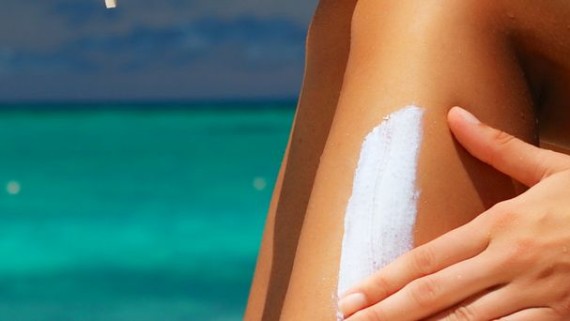How Sunscreen Can Increase Cancer Risk

Summer is finally here and if you spend any time at the park or the beach chances are you can smell the sunscreen in the air. Most of us have been brainwashed on how important sunscreen is that we don’t typically think about what’s in sunscreen, we just think we need it to help protect us from skin cancer. Skin cancer happens to be one of the most common forms of cancers in the US. I had malignant melanoma removed from my face when I was 20 so even though I think diet can play a huge role I am also a firm believer in the importance of sunscreen. The problem is that so many of the sunscreens out there actually contain ingredients that have actually been linked to premature aging and cancer.

photo credit Bigstock
Retinyl Palmitate.
Commonly used in sunscreen and facial moisturizers with spf it’s an antioxidant believed to slow skin aging. According to the National Toxicology Program by the US Department of Health and Human Services when it’s used on skin exposed to sunlight (which is typically where we wear sunscreen) it speeds the growth of cancerous tumors. There was even a study published in 2012 that showed it increases the development of skin cancer in animals that were exposed to UV treatment but instead of banning it the FDA ordered more tests to be done. Unfortunatley the FDA doesn’t regulate the cosmetic industry the same way it does with pharmaceuticals or foods (which is still pretty questionable with how many disease causing ingredients are allowed) so you really have to take it into your own hands to read ingredients on cosmetic labels too instead of assuming that things are safe.
Some more things to watch out for:
Sprays or powders with micronized and nano-scale zinc oxide. Inhaling these particles can potentially cause damage to the lungs to avoid sprays and instead find someone to help you put your sunscreen on. Avoiding these also means that the sunscreen will be more difficult to rub in – but your health is worth the extra minute or two.
Oxybenzone is rapidly absorbed through the skin and studies have linked it to endocrine disruption, cell damage and cancer.
Avoid fragrance unless it’s plant based. Federal law doesn’t require companies to declare the toxins in a single fragrance and they frequently contain phthalates, which may trigger allergic reactions and a host of other health problems.
When in doubt check the Environmental Working Groups Skin Deep website which lets you search your favorite products and lets you know just how toxic it really is.
Here is some more information on Vitamin A in sunscreen.
Choosing a safe sunscreen:
Avoid fragrances and instead opt for unscented sunscreen on ones that are scented using only essential oil.
Choose mineral based sunscreens that use titanium dioxide and zinc oxide and non-nano particles which do not penetrate the skin and also provide UVA protection. These ones are a little but harder to rub in but they are well worth the extra effort. Look for at least 7% zinc oxide.
Stick with lotion based sunscreens instead of the sprays.
My Favorite Sunscreens:
We use Badger sunscreen. It is certified organic and comes in different formulations.
Some other good choices include: Thinkbaby, Seventh Generation, California Baby (available at target) and Aubrey Organics.
Keep in mind that not all sunscreens that claim to be all natural are free of toxic and dangerous chemicals. To see how your sunscreen ranks check out the Environmental Working Group’s Sunscreen Guide. Ideally you want your sunscreen to be between a 0-2 on their rating, which means it has a low risk of toxic chemicals.
If you do happen to get a bit of a sunburn, take a look at some of my favorite all natural sunburn remedies.










